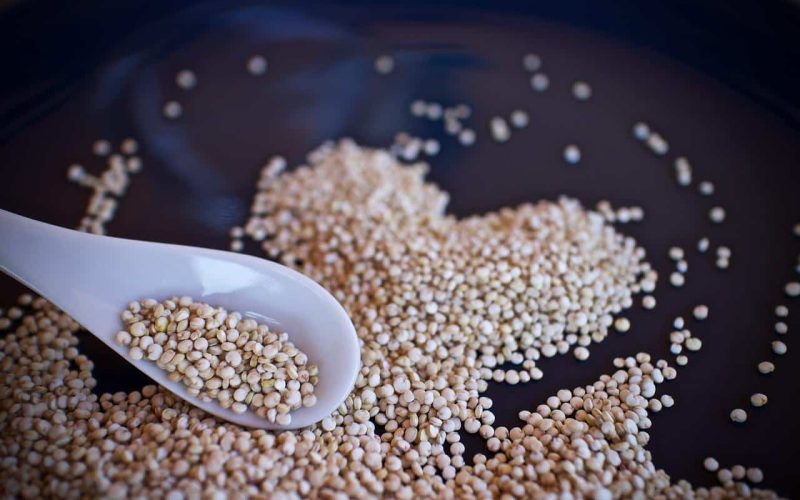Quinoa has captivated the culinary world over the past decade, aligning with dietary trends like gluten-free eating and the increased focus on “superfoods.”
While quinoa might appear modern, it has been a dietary staple for over 5,000 years, first cultivated in South America.
Quinoa is technically a seed and is related to beets and spinach. Cooking whole, dried quinoa involves simmering it in water or broth, similar to rice.
This process allows it to expand and fluff up, making it a versatile addition to salads, casseroles, or a simple side dish.
Given its adaptability, substituting quinoa with other similar grains is quite easy.
1. Rice
Rice serves as a versatile replacement for quinoa in many dishes. With a variety of options available on grocery store shelves, you can choose from types like long-grain, jasmine, or brown rice. Each type has its unique properties, making them suitable for different recipes.
When using rice as a quinoa substitute, the nutty flavor of brown rice comes particularly close. Both rice and quinoa complement bold flavors well, whether you’re creating a Mexican-inspired side dish or a Mediterranean salad.
Nutritional Comparison:
| Nutrient | Quinoa | Rice (White) | Rice (Brown) |
|---|---|---|---|
| Protein | High | Low | Medium |
| Amino Acids | Rich | Poor | Moderate |
| Micronutrients | High | Low | Moderate |
| Carbohydrates | Lower | Higher | Higher |
| Caloric Content | Similar | Similar | Similar |
| Fiber Content | Similar | Similar | Higher |
Quinoa offers more protein and essential amino acids, while rice provides higher carbohydrate content. Additionally, quinoa contains more micronutrients like iron and zinc. Despite these differences, both rice and quinoa have similar caloric and fiber contents, making rice a practical and tasty option in many recipes.
2. Couscous
Couscous is similar to quinoa due to its nutty and fluffy texture, making it an excellent base for various flavors. However, there’s an important difference. Quinoa is a seed derived from plants, while couscous is actually a type of pasta made from durum wheat semolina. This key distinction means couscous contains gluten, so it’s not suitable for those following a gluten-free diet.
For those who don’t need to avoid gluten, couscous can be an easy and tasty substitute for quinoa in many recipes. One advantage is how quickly and effortlessly it can be prepared. To cook couscous, simply bring water to a boil, pour it over the couscous, and cover it. In about 10 minutes, the couscous absorbs the liquid and becomes tender, ready to be fluffed with a fork and served.
Couscous pairs well with a variety of dishes and can be used in salads, as a side for meats or vegetables, and even in soups. Its versatility and quick cooking time make it a convenient alternative for many quinoa recipes. For a delicious and easy meal, try swapping quinoa with couscous in your usual dishes and enjoy the delightful texture and flavor it brings.
3. Barley
Barley is an ancient grain, similar to quinoa, and quite familiar to many home cooks. It stands out as one of the most popular grain crops globally. Barley has a chewy texture compared to quinoa’s fluffiness, making it distinct in various dishes.
Unlike quinoa, barley needs a longer cooking time, often up to an hour, while quinoa takes about 20 minutes. This lengthy cook time makes barley ideal for soups and stews where it can help thicken the dish. Thus, if you need a quinoa substitute for a soup, barley could be an excellent choice.
Barley contains gluten, so it is not suitable for gluten-free diets. Additionally, barley has less protein than quinoa but offers a good amount of minerals, essential acids, and vitamin B1. It’s a versatile grain that provides a different texture and nutritional profile, fitting well into many recipes that require a longer cooking period.
4. Chickpeas
Chickpeas, part of the legume family, provide a surprising yet effective substitute for quinoa in various recipes. Gluten-free and packed with protein and nutrients, chickpeas bring a lot to the table. They offer a nutty and mild flavor, making them perfect for use in salads or as an added texture in soups.
One of the biggest advantages of chickpeas is their convenience. While quinoa requires cooking, canned chickpeas are ready to use immediately. Just open the can, and they are good to go. For those who prefer dried chickpeas, soaking them before cooking allows for the same versatility in dishes.
Nutritional benefits of chickpeas:
- Calories: Low
- Protein: High
- Nutrients: Abundant
In terms of texture, chickpeas are softer but still hold a unique consistency that enhances many dishes. Whether you need a quick fix or want to experiment with a new ingredient, chickpeas can seamlessly replace quinoa without compromising flavor or nutritional value.
For more information on using chickpeas as a quinoa substitute, visit this guide on healthy substitutes.
5. Sorghum
Sorghum is an ancient grain known for its versatility and resemblance to quinoa. While many might recognize sorghum as a sweet syrup, it offers much more. Sorghum can be popped like popcorn, added to granola, or milled into flour for baked goods. As a substitute for quinoa, you can cook sorghum much like rice or quinoa itself—covered in hot water on the stove or in an Instant Pot.
Sorghum pairs well with ingredients that have warmer, sweeter flavors. Consider adding it to dishes that include ginger, cinnamon, nutmeg, or berries. It works particularly well in quinoa salads, providing a chewy texture that contrasts nicely with other ingredients.
| Characteristic | Details |
|---|---|
| Type | Ancient grain |
| Uses | Popped like popcorn, baked in granola, milled into flour |
| Cooking Method | Stove, Instant Pot |
| Flavor Pairings | Ginger, cinnamon, nutmeg, berries |
| Texture Benefit | Chewy |
For those looking for a nutritious and versatile quinoa substitute, sorghum is an excellent choice that adds both texture and flavor to a wide variety of recipes.
6. Teff
Teff, a lesser-known quinoa substitute, is the seed of a grass family plant. Although it can be hard to find and may cost more, teff offers several benefits. Teff is gluten-free and provides a good amount of fiber, protein, and B vitamins. Interestingly, teff contains more fiber and protein than quinoa.
To cook teff, use a 3:1 water-to-grain ratio and boil it for around 30 minutes. Its nutty flavor includes darker notes like coffee and molasses, making it versatile for both sweet and savory dishes. Some popular uses include pilafs and stews.
Teff pairs well with spices such as cinnamon, ginger, and cardamom, enhancing its rich flavor profile. While it might not replace quinoa in every recipe, it shines in many culinary applications. Whether used in hearty meals or delightful desserts, teff brings a unique taste and nutritional boost to the table.
7. Millet
Millet presents a flavor profile much like quinoa but looks and feels more like couscous. It lacks gluten, making it great for gluten-free recipes. It fits well in salads or serves as a tasty side dish when you would typically use quinoa. The small size and mild flavor of millet allow it to effortlessly blend with more pronounced ingredients.
Cooking millet requires attention, especially with the water ratio. Too much water turns millet into a mushy texture resembling grits or polenta. For a creamier, denser result, cook millet longer with extra water. However, to mimic quinoa’s texture, use a two-to-one water-to-millet ratio. Simmer this mixture for about 20 minutes to achieve a fluffy consistency instead of clumps.
For a hands-off approach, prepare millet in an Instant Pot. This method reduces the need to watch over the stove constantly. Whether on the stove or in an Instant Pot, millet can be a versatile and delightful addition to many meals.
8. Kamut
Kamut stands out as a protein-packed pantry staple, boasting more protein than quinoa. With a nutty flavor and a firm texture, it makes a tasty addition to pilafs and casseroles. Kamut contains 7.4 grams of fiber and 9.8 grams of protein per cup, surpassing quinoa’s 5 grams of fiber and 8 grams of protein. This nutritional profile makes kamut an excellent choice for health-conscious individuals.
However, kamut is not suitable for anyone who needs to avoid gluten, as it is a wheat grain that contains gluten. Additionally, kamut isn’t the best option for those seeking a quick-cooking substitute for quinoa. It requires boiling for up to an hour before it is ready to eat.
Cooking in batches can solve this issue. Once prepared, kamut can be stored and used later, adding a hearty texture to cold salads and other dishes. This flexibility can help make meal prep easier for those with busy schedules, offering a nutritious and delicious alternative to traditional grains.
9. Amaranth
Amaranth, like quinoa, is an ancient grain that hails from South America and is actually a seed. This gluten-free option cooks in a similar time frame and manner as quinoa. The flavor, however, is where amaranth stands out. Unlike the milder quinoa, amaranth delivers a bold, distinctive taste, with sweet, nutty notes and a grassy aroma. This makes it a unique inclusion in dishes like bowls or sides, though its grassy scent might not appeal to everyone.
Nutritionally, amaranth differs from quinoa in a few notable ways. It has a higher calorie, fat, and carb content, which might not make it the best choice for those watching their intake. Despite this, its rich flavor can enhance many recipes. To explore more about using amaranth in your meals, visit the list of substitutes for quinoa.
Comparison Table: Amaranth vs. Quinoa
| Nutrient | Amaranth | Quinoa |
|---|---|---|
| Calories | Higher | Lower |
| Fat | Higher | Lower |
| Carbohydrates | Higher | Lower |
| Flavor | Bold, Nutty | Mild |
| Cooking Time | Similar | Similar |
| Aroma | Grassy | Neutral |
Amaranth’s boldness can elevate simple dishes, making it an interesting alternative for culinary exploration.
10. Lentils
Lentils offer a hearty and satisfying alternative to quinoa. They work well in soups, stews, and salads, providing more texture and substance. There are several varieties of lentils, such as red, yellow, green, black, and brown. Each type has its unique characteristics:
- Green lentils: Best for salads due to their firm texture.
- Brown lentils: Ideal for dishes needing extra texture.
- Red and yellow lentils: Perfect for soups and stews as they break down and become creamy.
Lentils have a bean-like flavor, which might not appeal to everyone. Yet, in recipes with strong, savory flavors, they shine. Their ability to absorb and complement bold tastes makes them a versatile ingredient.
Moreover, lentils match quinoa in their fiber content, offering eight grams per cup. This makes them a nutritious choice for many dishes. Whether used in a salad or a hearty stew, lentils bring both flavor and nutrition to the table. For more details, you can check out this article.
11. Grits
Grits, made from ground corn, are a staple in Southern cuisine. They are commonly served with breakfast or alongside seafood. The texture can vary based on the type bought and how they are cooked. Notably, traditional grits take longer to cook compared to other grains, but the outcome is a creamy, thick dish that is incredibly comforting.
One thing to remember is that grits may not be the best replacement for quinoa in salads or soups. However, they can be used in similar flavor profiles for simpler quinoa side dishes when you’re out of quinoa. To prepare grits, it’s typically best to soak them overnight. The standard cooking ratio is four parts liquid to one part grits.
Grits are versatile and can be paired with a range of strong flavors. They work well with ingredients like cheese, capers, and hot sauce due to their mild taste. This flexibility makes them a great addition to many meals, enhancing the overall dining experience.
Although different from quinoa, grits bring a unique texture and taste to the table, offering comfort and variety in many dishes.
12. Farro
Farro, an ancient grain similar to quinoa, offers a versatile option for various dishes. Known by other names like einkorn, emmer, and spelt, most farro available in stores is the emmer variety. This grain has a chewy texture and a nutty taste, making it a great addition to meals. It can be prepared in two ways: either like rice or like pasta.
When cooking farro like rice, you allow the grain to absorb water as it cooks, resulting in a tender texture. On the other hand, if you decide to cook it like pasta, you should boil it in a generous amount of salted water and then drain it once it reaches your preferred consistency.
While farro is often labeled as an ancient grain, it contains wheat and is not gluten-free. This makes it unsuitable for those needing a gluten-free alternative. For those without gluten restrictions, farro works well in recipes that call for quinoa’s nutty flavor and slight chewiness. It shines in salads and side dishes, providing a delightful texture and taste.
Quick Farro Facts:
- Other Names: Einkorn, Emmer, Spelt
- Texture: Chewy
- Flavor: Nutty
- Gluten Content: Contains wheat
- Cooking Methods: Rice-style absorption, pasta-style boiling
By incorporating farro into your diet, you can enjoy its rich, nutty flavor and unique texture in a variety of dishes.








